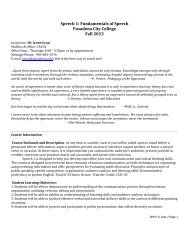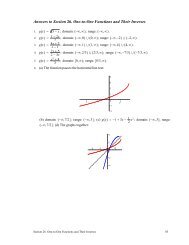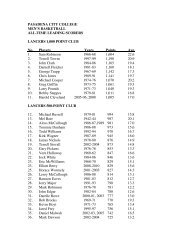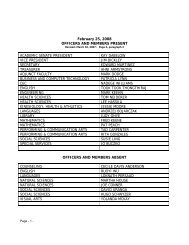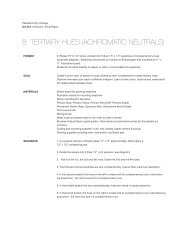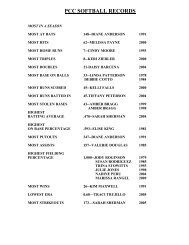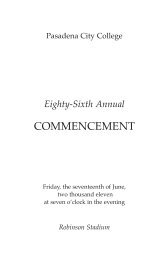Narratives of the Self
Narratives of the Self
Narratives of the Self
You also want an ePaper? Increase the reach of your titles
YUMPU automatically turns print PDFs into web optimized ePapers that Google loves.
Chapter 12<br />
NARRATIVES OF THE SELF<br />
Kenneth J. Gergen and Mary M. Gergen<br />
Man is always a storyteller! He lives surrounded by his and o<strong>the</strong>rs' myths.<br />
With rhrm he sees everything in his lifr, no matter what befalls him. And<br />
he seeks to liv~his life as though he were telling it. (Sartre)<br />
Traditionally inquiry into self-conception has been concerned with<br />
states <strong>of</strong> being, that is, with <strong>the</strong> individual as a stabilized entity. The<br />
research concern has been essentially triadic. It has first entailed <strong>the</strong><br />
development <strong>of</strong> a wide variety <strong>of</strong> measuring instruments designed to tap <strong>the</strong><br />
structure, content, and evaluative underpinning <strong>of</strong> <strong>the</strong> individual's self-<br />
conception at a given rime. Second, it has focused on various factors that<br />
could figure in <strong>the</strong> determination and alteration <strong>of</strong> <strong>the</strong> individual's con-<br />
ception <strong>of</strong> self. Finally it has been occupied with <strong>the</strong> effects <strong>of</strong> a given<br />
configuration <strong>of</strong> self-conception on subsequent activity. Thus, for example,<br />
researchers have developed instruments for assessing self-esteem, have<br />
examined a range <strong>of</strong> formative influences, and explored <strong>the</strong> behavioral<br />
implications <strong>of</strong> possessing various levels <strong>of</strong> self-esteem. Yet, in spite <strong>of</strong> <strong>the</strong><br />
many insights generated in this traditional orientation to self, it is important<br />
to recognize its limitations. In doing so, we may become sensitized to<br />
significant lacunae in <strong>the</strong>oretical development. It is just such limitations in<br />
<strong>the</strong> traditional orientation that set <strong>the</strong> stage for <strong>the</strong> present undertaking.<br />
Work on rhe prcsmr chapter was facilitated by a grant from <strong>the</strong> National Science<br />
Fvundarion (47809393) and rhe working facilities ar Heidelberg University so graciously<br />
provided bv Carl F. Graumen. We wish also to express our appreciation to <strong>the</strong> following<br />
friends whose relf~narrativergave us inspiration for this chapter Winston J. Churchill,<br />
Deborah Cuniss. Emil Liebman, Harvey S. Miller, and Dagmar Wesrrict<br />
254<br />
NARRATIVES OF THE SELF / 255<br />
Traditional research on self-conception is earmarked by two widel"<br />
prevailing characteristics: such research tends to be both mechantrtic and<br />
qn~hronic. It is mechanistic in its assumption <strong>of</strong> an internal structure<br />
golemed in mechanical fashion by external inputs, and it is synchronic in<br />
its concern with <strong>the</strong> causes and effects <strong>of</strong> <strong>the</strong> individual's characterization <strong>of</strong><br />
him or herself at a given moment. Thus <strong>the</strong> individual is generally imbued<br />
8 with a structure <strong>of</strong> self-descriptions (concepts, schemata, prototypes) that<br />
remains stabilized until subjected to external influences from <strong>the</strong> social<br />
surroundings. While revealing in certain respects, such orienting assump-<br />
tions are myopic in o<strong>the</strong>rs. First, <strong>the</strong>y ignore <strong>the</strong> individual's capacity to<br />
shape actively <strong>the</strong> configuration <strong>of</strong> self-conception. They deny <strong>the</strong> potential<br />
<strong>of</strong> <strong>the</strong> individual for reflexive reconstruction <strong>of</strong> self-understanding. Needed<br />
<strong>the</strong>n is attention to <strong>the</strong> ways in which <strong>the</strong> individual actively constructs his<br />
or her view <strong>of</strong> selt not as a pawn to social inputs, but as a constmctive agent<br />
in social life. Second, <strong>the</strong> traditional views fail to appreciate <strong>the</strong> individual's<br />
understanding <strong>of</strong> him or herself as a historically emerging being. It may he<br />
argued .that one's view <strong>of</strong> self in a given moment is fundamentally<br />
nonsensical unless it can be linked in some fashion with his or her past.<br />
Suddenly and momentarily to see oneself as "fat," "poetic," or "male," for<br />
example, might seem mere whimsy unless such concepts could be attached<br />
to a temporal context revealing <strong>the</strong>ir genesis. How did it come about that<br />
such terms are being employed in <strong>the</strong> present context? The fact that people<br />
believe <strong>the</strong>y possess identities fundamentally depends on <strong>the</strong>ir' capacity to<br />
relate fragmentary occurrences across temporal boundaries. The present<br />
analysis, specifically concerned with <strong>the</strong> individual's active construction <strong>of</strong><br />
personal history, is thus reflexive and diachronic. It is concerned with states <strong>of</strong><br />
active becoming as opposed to passive being.<br />
We shall employ <strong>the</strong> term "self-narrative" to refer to <strong>the</strong> individual's<br />
account <strong>of</strong> <strong>the</strong> relationship among self-relevant events across time. In<br />
developing a self-narrative <strong>the</strong> individual attempts to establish coherent<br />
connections among life events (Cohler, 1979; Kohli, 1981). Ra<strong>the</strong>r than<br />
seeing one's life as simply "one damned thing after ano<strong>the</strong>r," <strong>the</strong> individual<br />
attempts to understand life events as systematically related. They are<br />
rendered intelligible by locating <strong>the</strong>m in a sequence or "unfolding process"<br />
(de Waele & Harrk, 1979). One's present identity is thus not a sudden and<br />
mysterious event, but a sensible result <strong>of</strong> a life story. As Bettelheim (1976)<br />
has argued, such creations <strong>of</strong> narrative order may be essential in giving<br />
one's life a sense <strong>of</strong> meaning and direction.'<br />
It is <strong>the</strong> purpose <strong>of</strong> <strong>the</strong> present chapter to open consideration <strong>of</strong> <strong>the</strong><br />
manner in which people construct narratives for <strong>the</strong> self. Our analysis is<br />
divided into two parts. First we shall consider narrative forms, in both <strong>the</strong>ir<br />
temporal and dramatic aspects. The attempt in this case will be to develop a<br />
means <strong>of</strong> characterizing forms <strong>of</strong> narrative. Using this analysis as grounding
we can turn to <strong>the</strong> relationship <strong>of</strong> self-narratives to social interaction.<br />
Although self-narratives are possessed by individuals, <strong>the</strong>ir genesis and<br />
sustenance may he viewed as fundamentally social. The function <strong>of</strong> dif-<br />
fering narrative forms along with <strong>the</strong>ir construction in social interaction will<br />
be <strong>of</strong> particular concern.<br />
Before embarking on this analysis a word must he said about <strong>the</strong><br />
relationship between <strong>the</strong> concept <strong>of</strong> self-narrative and related <strong>the</strong>oretical<br />
notions. In particular, <strong>the</strong> concept <strong>of</strong> self-narrative bears an affinity with a<br />
variety <strong>of</strong> constructs falling generally within <strong>the</strong> domains <strong>of</strong> rule-role and<br />
dramaturgical <strong>the</strong>ory. However, <strong>the</strong>re are significant distinctions. The<br />
concepts <strong>of</strong> rule (Harre & Secord, 19721, role prescription (Sarhin & Allen,<br />
1968-1969). interaction ritual (G<strong>of</strong>fman, 19741, and scripts (Schank &<br />
Abelson, 1977) have all been employed in dealing with <strong>the</strong> psychological<br />
basis for sequences <strong>of</strong> action across time.. Fur<strong>the</strong>r, in each case, <strong>the</strong>orists<br />
have generally assumed an autonomous base for human action. In <strong>the</strong>se<br />
respecrs such terms are similar to <strong>the</strong> concept <strong>of</strong> self-narrative. However,<br />
unlike thr latter concept, <strong>the</strong>orists in each <strong>of</strong> <strong>the</strong>se cases have tended to<br />
assign governing or directive functions to <strong>the</strong> various structures. That is, <strong>the</strong><br />
individual is said to consult or interrogate <strong>the</strong> relevant rule, role prescrip<br />
tion, ritual understanding, or script for indications <strong>of</strong> proper or appropriate<br />
conduct. The individual thus carries with him or her a psychological<br />
template relevant to interaction sequences, and assesses <strong>the</strong> propriety <strong>of</strong> his<br />
or her behavior in accord with <strong>the</strong> template. In contrast, we view <strong>the</strong> self-<br />
narrative as possessing no inherent directive capabilities. Ra<strong>the</strong>r, it may be<br />
viewed as a construction undergoing continuous alteration as interaction<br />
progresses. The individual in this case does not consult <strong>the</strong> narrative for<br />
information.' Ra<strong>the</strong>r, <strong>the</strong> self-narrative is a linguistic implement constructed<br />
and reconstructed by people in relationships, and employed in<br />
Irelationships to sustain, enhance, or impede various actions. In this sense,<br />
self-narratives function much as histories within <strong>the</strong> society more generally.<br />
Histories do not in <strong>the</strong>mselves have directive capacities. They are symbolic<br />
systems used for such social purposes as justification, criticism, and social<br />
solidification.<br />
DIMENSIONS OF NARRATIVE FORM<br />
Man, in a word, has no nature; what he has is. . . history. (Ortega y Gasset)<br />
To argue that individuals attempt to knit <strong>the</strong>ir life events into coherent<br />
sequences is to open <strong>the</strong> door to a variety <strong>of</strong> interesting and important<br />
issues. What functions do self-narratives play in <strong>the</strong> life <strong>of</strong> <strong>the</strong> individual;<br />
can self-narratives be distinguished in terms <strong>of</strong> <strong>the</strong>ir functional as opposed<br />
"T NARRATIVES OF THE SELF 1 257<br />
to dysfunctional capacities; what are <strong>the</strong> origins <strong>of</strong> self-narratives; and what<br />
relationship do such narratives bear to social life more generally? Inquiry<br />
into such issues depends importantly on <strong>the</strong> existence <strong>of</strong> a differentiated<br />
vocabulary <strong>of</strong> narrative form. Without distinctions among narrative forms<br />
<strong>the</strong>oretical explorations <strong>of</strong> <strong>the</strong>se various issues may remain shallow or<br />
constrained. Although a full elaboration <strong>of</strong> narrative form is beyond <strong>the</strong><br />
scope <strong>of</strong> this chapter, our later discussion <strong>of</strong> <strong>the</strong> social context <strong>of</strong> narrarivr<br />
will benefit from consideration <strong>of</strong> two major aspects <strong>of</strong> form: <strong>the</strong> temporal<br />
and <strong>the</strong> dramatic.<br />
TEMPORAL FORM IN SELF-NARRATIVE<br />
One essential aspect <strong>of</strong> narrative is <strong>the</strong> capacity to generate directionality<br />
amongevents; that is, to structure <strong>the</strong> events in such a way that <strong>the</strong>y<br />
move over time in an orderly way toward a given end.3 Our initial question<br />
concerning this temporal aspect <strong>of</strong> narrative concerns that <strong>of</strong> variations in<br />
form. On what grounds can one distinguish among forms <strong>of</strong> ten~poral<br />
sequence? There are few available resources on which to draw in answering<br />
this question. The most extensive accounts <strong>of</strong> variations in narrative form<br />
are found in <strong>the</strong> analysis <strong>of</strong> drama and literature. In his analysis <strong>of</strong> mythical<br />
forms, for example, Northrup FN~ (1957) argues that <strong>the</strong>re are four basic<br />
forms <strong>of</strong> narrative, each <strong>of</strong> which is rooted in <strong>the</strong> human experierrcc with<br />
nature and most particularly with <strong>the</strong> evolution <strong>of</strong> <strong>the</strong> seasons. Thus, <strong>the</strong> ,<br />
experience <strong>of</strong> spring and <strong>the</strong> uprising <strong>of</strong> nature gives rise to <strong>the</strong> comedy. In<br />
<strong>the</strong> classic tradition comedy typically, involves a challenge or threat, which is<br />
overcome to yield a happy ending. A comedy need not be humorous. It is,<br />
ra<strong>the</strong>r, similar to what is now popularly called a melodrama. Problematic<br />
situations develop and are overcome. In contrast, <strong>the</strong> free and calm <strong>of</strong><br />
summer days give inspiration to <strong>the</strong> romance as a dramatic form. The<br />
romance in this case consists <strong>of</strong> a series <strong>of</strong> episodes in which <strong>the</strong> major<br />
protagonist experiences challenges or threats and in each case ernerges<br />
victorious. The romance need not be concerned with attraction between<br />
people. During <strong>the</strong> autumn, when one experiences <strong>the</strong> contrast between <strong>the</strong><br />
life <strong>of</strong>summer and <strong>the</strong> death <strong>of</strong> comingwinter, <strong>the</strong> tragic form is born; and in<br />
winter, with one's increasing awareness <strong>of</strong> unrealized expectancies and <strong>the</strong><br />
death <strong>of</strong> dreams, irony and satire become relevant expressive forms.<br />
Joseph Campbell's (1949) analysis <strong>of</strong> primitive myth is helph~l. As he<br />
proposes, <strong>the</strong>re is one central "monomyth" from which a myriad <strong>of</strong><br />
variations have been drawn in primitive mythology. The monornyth, rooted<br />
in unconscious psychodynamics, concerns <strong>the</strong> hero who has been abl~ to<br />
overcome personal and historical limitations to reach a transcendent<br />
understanding <strong>of</strong> <strong>the</strong> human condition. For Campbell. heroic narratives in<br />
"<br />
:<br />
.<br />
. ..<br />
. '.<br />
I<br />
I
<strong>the</strong>ir many local guises serve vital functions <strong>of</strong> psychic education. For our<br />
purposes, we see that <strong>the</strong> monomyth carries a form similar to that <strong>of</strong> <strong>the</strong><br />
comedy-melodrama. That is, negative events (trials, terrors, tribulations)<br />
are followed by a positive outcome (enlightenment).<br />
These discussions enable us to shift to a more abstract perspective.<br />
What is common to <strong>the</strong> sequential shift we find in <strong>the</strong> tragedy, <strong>the</strong> comedymelodrama,<br />
<strong>the</strong> romantic saga, and <strong>the</strong> monomyth are shifts in <strong>the</strong><br />
evaluative character <strong>of</strong> events over time. Essentially, we seem to be<br />
confronted with alterations in a primary dimension <strong>of</strong> human experience,<br />
<strong>the</strong> evaluative (cf Gordon, 1968, 1976; Osgood, Suci & Tannenbaum, 1957;<br />
Wells & Manuell, 1976). That is, in linking experiences <strong>the</strong> dramatist<br />
appears to establish directionality along a good-bad dimension. Or, as<br />
Alasdair MacIntyre (1977) has put it, "Narrative requires an evaluative<br />
framework in which good or bad character helps to produce unfortunate or<br />
happy outcomes" (p. 456). Do such alterations have a counterpart in <strong>the</strong><br />
person's attempt to understand his or her cross-time trajectory? It would<br />
appear so, as attested to by such common queries as: "Am I improving?"<br />
"Is my life happier now?" "Are my abilities declining?' " Am 1maintaining<br />
<strong>the</strong> high standards I once committed myself to?" or "Am I growing as a<br />
person?" To answer such questions <strong>the</strong> individual selects discrete incidents<br />
or images occurring across time and links <strong>the</strong>m through evaluative comparison<br />
(cf Hankiss, 1981; Labor & Waletzky, 1967).<br />
Given what appears to be a fundamental means <strong>of</strong> generating coherence<br />
and direction over time, we can proceed more formally to consider<br />
<strong>the</strong> problem <strong>of</strong> narrative types. At <strong>the</strong> most rudimentary level we may<br />
isolate three forms - <strong>of</strong> narrative. The first may be described as a stability<br />
- narrative, that is, a narrat~veGlinks incidents, images, or concepti;n such<br />
a way that <strong>the</strong> individual remains essentially unchanged with respect to<br />
~valuative position. As depicted in Figure 12-1, we also see that <strong>the</strong> stability<br />
narrative could be struck at any level along <strong>the</strong> evaluative continuum. At <strong>the</strong><br />
upper end <strong>of</strong> <strong>the</strong> continuum <strong>the</strong> individual might conclude, for example, "I<br />
am still as attractive as I used to be," or at <strong>the</strong> lower end, "I continue to be<br />
haunted by feelings <strong>of</strong> failure." As can also be seen, each <strong>of</strong> <strong>the</strong>se narrative<br />
summaries possessrs inherent implications for <strong>the</strong> future. That is, <strong>the</strong>y<br />
furnish an indication or anticipation <strong>of</strong> forthcoming events. In <strong>the</strong> former<br />
case <strong>the</strong> individual might conclude that he or she will continue to be<br />
attractive for <strong>the</strong> foreseeable future and, in <strong>the</strong> latter, that feelings <strong>of</strong> failure<br />
will persist regardless <strong>of</strong> circumstance.<br />
This rudimentary narrative may be contrasted with two o<strong>the</strong>rs <strong>of</strong><br />
similar simplicity. The individual may link toge<strong>the</strong>r experiences in such a<br />
way that ei<strong>the</strong>r increments or decrements characterize movement along <strong>the</strong><br />
evaluative dimension over time. In <strong>the</strong> former case we may speak <strong>of</strong><br />
pro,gr~sriii~,and in <strong>the</strong> latter re,qessiue, narratives (see Figure 12-2). For<br />
--T<br />
.<br />
TlME -<br />
NARRATIVES OF THE SELr 1 259<br />
Figure 12.1. Positive (N,) and Negative (N,) Stability <strong>Narratives</strong><br />
example, <strong>the</strong> individual might be engaged in a progressive narrative wit11<br />
<strong>the</strong> surmise, "I am really learning to overcome my shyness and be more<br />
open and friendly with people," or a regressive narrative with <strong>the</strong> thought.<br />
"I can't seem to control <strong>the</strong> events in my life anymore." Directionality is<br />
also implied in each <strong>of</strong> <strong>the</strong>se narratives with <strong>the</strong> former anticipating fur<strong>the</strong>r<br />
increments and <strong>the</strong> latter fur<strong>the</strong>r decrements.<br />
As should be clear, <strong>the</strong>se three narrative forms, stability, progressive,<br />
and regressive, exhaust <strong>the</strong> fundamental options for <strong>the</strong> direction <strong>of</strong><br />
movement in evaluative space. As such <strong>the</strong>y may he considered rudimentary<br />
bases for o<strong>the</strong>r more complexvariants. Theoretically one may envision<br />
a potential infinity <strong>of</strong> variations on <strong>the</strong>se rudimentary forms. However, for<br />
reasons <strong>of</strong> social utility, aes<strong>the</strong>tic desirability, and cognitive capability, thr<br />
culture may limit itself to a truncated repertoire <strong>of</strong> possibilities. Among this<br />
limited set we may place <strong>the</strong> tragic narrative, which in <strong>the</strong> present<br />
framework would adopt <strong>the</strong> structure depicted in Figure 12-3. The tragedy.<br />
in this sense, would tell <strong>the</strong> story <strong>of</strong> <strong>the</strong> rapid downfall <strong>of</strong> one who had<br />
achieved high position. A progressive narrative is thus followed by a rapid<br />
regressive narrative.<br />
!i/l-\<br />
In this sense <strong>of</strong> comedy-melodrama is <strong>the</strong> reverse <strong>of</strong><br />
<strong>the</strong> tragedy: A regressive narrative is followed by a progressive narrativ~.<br />
: A<br />
E 1 - -<br />
-<br />
TIME TIME<br />
Figure 12.2. Progressive (N,) and Regressive (N,) <strong>Narratives</strong>
- TIME TIME<br />
--L<br />
Figure 12.3. Tragic (N,) and Comedy-Melodrama (N,) <strong>Narratives</strong><br />
Life event become increasingly problematic until <strong>the</strong> denouement, where-<br />
upon happiness is rapidly restored to <strong>the</strong> major protagonists. Fur<strong>the</strong>r, if a<br />
progressive narrative is followed by a stdbility narrative (see Figure 12-4), we<br />
have what is commonly known as <strong>the</strong> happily-ever-after myth, which is<br />
widely adopred in traditional courtship. And we also recognize <strong>the</strong> roman-<br />
tic saga as a series <strong>of</strong> progressive-regressive phases. In this case, for<br />
example, <strong>the</strong> individual may see his or her past as a continuous array <strong>of</strong><br />
battles against <strong>the</strong> powers.<strong>of</strong> darkness.<br />
Before considering a second aspect <strong>of</strong> narrative form two matters<br />
deserve brief attention. First, as should be apparent from this discussion,<br />
narrative forms are in no way to be construed as objective reflections <strong>of</strong><br />
one's personal life. The individual should be able to use virtually any form<br />
to account for his or her life history. Particular narratives may be implied by<br />
<strong>the</strong> manner in which one evaluates <strong>the</strong> events entering into <strong>the</strong> narrative<br />
construction. However, events <strong>the</strong>mselves do not contain inherent valua-<br />
tional properties. Such properties must be attributed, and <strong>the</strong> attributions<br />
ar? contained within <strong>the</strong> particular constructions one makes <strong>of</strong> <strong>the</strong> events.<br />
Whe<strong>the</strong>r any given event is good or bad depends on <strong>the</strong> framework one<br />
-<br />
TIME -<br />
TIME<br />
-<br />
Figure 12.4. "Happily-Ever-After" (N,) and Romantic Saga (N,) <strong>Narratives</strong><br />
NARRATIVES OF THE SELF I 201<br />
employs for understanding, and <strong>the</strong> potential array <strong>of</strong> frameworks for<br />
rendering events intelligible is without apparent limit.'<br />
Second, although many illustrations <strong>of</strong> <strong>the</strong>se narrative forms can he<br />
found in <strong>the</strong> arts, this is not simultaneously to accept <strong>the</strong> enticin: but<br />
problematic view that life accounts are merely reconstituted forms <strong>of</strong> art. To<br />
be sure, from children's fairytales to television serials, from primitive<br />
religious myths to <strong>the</strong> most sophisticated novel, <strong>the</strong> narratives outlined rhus<br />
far recur with great regularity. And, one can scarcely imagine that those who<br />
are frequently exposed to such forms could remain unaffected by <strong>the</strong>m.<br />
Bettelheim's (1976)analysis <strong>of</strong> <strong>the</strong> pr<strong>of</strong>ound effects <strong>of</strong> fairytales in <strong>the</strong> life <strong>of</strong><br />
<strong>the</strong> developing child is quite compelling in this respect. Yet, at <strong>the</strong> same<br />
time such forms are not necessarily <strong>the</strong> inventions <strong>of</strong> autonomous storv-<br />
tellers, witchdoctors, or literary craftsmen. Such individuals are also<br />
members <strong>of</strong> <strong>the</strong>ir culture and can scarcely remain unaffected bv <strong>the</strong><br />
narrative forms that are already imbedded <strong>the</strong>rein.' Life and art are thus<br />
interdependent. However, that similar narrative forms may be found over<br />
many historical periods and differing contexts suggt-sts that <strong>the</strong>ir fun-<br />
damental genesis may he furnished by <strong>the</strong> requisites <strong>of</strong> human interac~ion.<br />
We shall return to this issue in treating <strong>the</strong> social utility <strong>of</strong> narrative fonns.<br />
DRAMATIC ENGAGEMENT IN NARRATIVE FORM<br />
We now see how coherence among events may be produced through<br />
evaluative contrasts. However, we have said little about one <strong>of</strong> <strong>the</strong> most<br />
phenomenologically salient aspects <strong>of</strong> narrative form: <strong>the</strong> capacity to create<br />
feelings <strong>of</strong> drama or emotion. We may refer to this aspect <strong>of</strong> narrative form<br />
in terms <strong>of</strong> dramatic engagement. In <strong>the</strong> same way that <strong>the</strong>atrical produc-<br />
tions vary in <strong>the</strong>ir capacity to arouse and compel an audience, so may <strong>the</strong><br />
individual's selection <strong>of</strong> narrative vary in its capacity to generate or reduce<br />
dramatic tension in one's life. How are we to understand <strong>the</strong> elements<br />
giving rise to <strong>the</strong>se variations in emotional engagrment? Of course,<br />
dramatic engagement cannot he separated entirely from <strong>the</strong> content <strong>of</strong> a<br />
given narrative. Yet, segmented events in <strong>the</strong>mselves appear limited in <strong>the</strong>ir<br />
capacity to sustain engagement. For example, a film depicting <strong>the</strong> con-<br />
tinuous, random juxtaposition <strong>of</strong> startling events (a gunshot, a sword<br />
waving, a horse jumping a wall, a low-flying aircraft) would soon produce<br />
tedium. It is <strong>the</strong> relationship among events, not <strong>the</strong> events <strong>the</strong>mselves, that<br />
seems chiefly responsible for sustaining dramatic engagement, and a <strong>the</strong>ory<br />
<strong>of</strong> narrative form is essentially concerned with such relationships. What<br />
characteristics <strong>of</strong> narrative form are necessary, <strong>the</strong>n, to generate dramatic<br />
engagement?<br />
At this preliminaryjuncture, one must again look at <strong>the</strong> dramatic arts
as a source <strong>of</strong> insight. In this case, it is <strong>of</strong> initial iriterest that one can scarcely<br />
locate a <strong>the</strong>atrical exemplar <strong>of</strong> <strong>the</strong> three rudimentary narratives proposed<br />
above. A drama in which all events were evaluatively equivalent (stability<br />
narrarive) would scarcely be considered drama. Fur<strong>the</strong>r, a steady but<br />
modrrate enhancement (progressive) or decrement (regressive narrative) in<br />
a protagonist's life conditions would also seem to produce ennui. At <strong>the</strong><br />
same time, it is also interesting to observe that <strong>the</strong> tragic narrative depicted<br />
in Fi\pre 12-3 hears a strong resemblance to <strong>the</strong> simpler, but unarousing<br />
regressive narrative (Figure 12-2). How does <strong>the</strong> tragic narrative, with its<br />
consisrentlv powerful dramatic impact, differ from <strong>the</strong> more rudimentary<br />
regressive narrative? Two characteristics seem particularly significant. First,<br />
we note that <strong>the</strong> relative decline in events is far less rapid in <strong>the</strong> prototypical<br />
regressive narrative lhan it is in <strong>the</strong> case <strong>of</strong> <strong>the</strong> tragic narrative. Whereas <strong>the</strong><br />
former is characterized bv moderate decline over time, <strong>the</strong> latter organized<br />
events in such a way that decline is precipitous. In this light one may<br />
conjecture that <strong>the</strong> rapidity with which events deteriorate in such classic<br />
tragedies as Anliqone, Oed$us Rex, and Romeo andJuliet may he essential to<br />
<strong>the</strong>ir dramatic impact. More generally, it may be suggested that <strong>the</strong> rate <strong>of</strong><br />
change. or more formally <strong>the</strong> acceleration <strong>of</strong> <strong>the</strong> narrative slope, constitutes<br />
one <strong>of</strong> <strong>the</strong> chief components <strong>of</strong> what is here termed dramatic engagement.<br />
A second major component is also suggested by <strong>the</strong> contrast between<br />
<strong>the</strong> regressive and <strong>the</strong> tragic narratives. In <strong>the</strong> former case (see Figure 12-2)<br />
<strong>the</strong>re is unidirectionality in <strong>the</strong> slope line whereas in <strong>the</strong> tragic narrative<br />
(Figure 12-3) we find a progressive narrative (sometimes implied) followed<br />
by a regressive narrative. It would appear to be this "turn <strong>of</strong> events," or<br />
more precisely <strong>the</strong> change in <strong>the</strong> evaluative relationship amongevents, that<br />
contributes to a high degree <strong>of</strong> dramatic engagement. It is when <strong>the</strong><br />
individual who has attained high goals, has reached <strong>the</strong> apex <strong>of</strong> ecstasy, or<br />
has at last discovered life's guiding principle, is brought low that drama is<br />
created. In more formal terms, <strong>the</strong> alteration in narrative slope may be<br />
considered a second major component <strong>of</strong> dramatic engagement.<br />
When we consider both alteration in and acceleration <strong>of</strong> narrative slope<br />
as basic components <strong>of</strong> dramatic engagement, we are led to a more general<br />
conclusion. Both <strong>of</strong> <strong>the</strong>se components are similar in one respect: <strong>the</strong>y both<br />
point to some aspect <strong>of</strong> phenomenal change as a basis <strong>of</strong> dramarir ren~inn<br />
~~~<br />
Acceleration and alteration in slope may be viewed as two realizations <strong>of</strong><br />
this more fundamental experience.<br />
MACRO-, MICRO- AND MULTIPLES IN NARRATIVE FORM<br />
Mv characters are conglomerations <strong>of</strong> past and present stages <strong>of</strong> civiliza-<br />
tions, bits from books and newspapers, scraps <strong>of</strong> humanity, rags and<br />
rattrrs <strong>of</strong>fir~rlorh~ng.patched togethcr as is <strong>the</strong> human soul. (Strindberg)<br />
7-<br />
I<br />
I<br />
!<br />
NARRATIVES OP I HP. >C.LZ 1 LO5<br />
Thus far we have attempted to outline a number <strong>of</strong> rudirnentar),<br />
narrative forms, along with some <strong>of</strong> <strong>the</strong>ir more common derivatives, and to<br />
open discussion on differences in dramatic impact. We must now turn our<br />
attention more directly to <strong>the</strong> operation <strong>of</strong> narrative forms in dailv life. This<br />
account will have two aspects. In <strong>the</strong> first instance we may consider <strong>the</strong><br />
normal capacities with which <strong>the</strong> individual enters social relationships, and<br />
in <strong>the</strong> second, <strong>the</strong> function and development <strong>of</strong> narratives in interpersonal<br />
encounters. In inquiring into personal capacities it is important to appre-<br />
ciate <strong>the</strong> individual's exposure to a milieu <strong>of</strong> multiple narratives. Normal<br />
socialization will typically <strong>of</strong>fer <strong>the</strong> individual exposure to a wide variety <strong>of</strong><br />
narrative forms, from <strong>the</strong> rudimentary to <strong>the</strong> complex. Thus, <strong>the</strong> individual<br />
typically enters relationships with a potential for employing any <strong>of</strong> a wide<br />
number <strong>of</strong> forms. In <strong>the</strong> same way an expeiienced skier approaches a steep<br />
incline with a variety <strong>of</strong> techniques for effective descent or a teacher<br />
confronts a class with a variety <strong>of</strong> means for effective communication, so thr<br />
individual can usually construct <strong>the</strong> relationship among life experiences in<br />
a variety <strong>of</strong> ways. At a minimum, effective socialization should equip <strong>the</strong><br />
person to interpret life events as constancies, as improvements, or as<br />
decrements. And, with little additional training, <strong>the</strong> individual should<br />
develop <strong>the</strong> capacity to envision his or her life as tragedy, comeclvmelodrama,<br />
or a romantic epic.<br />
Not only do people enter social relationships with a variety <strong>of</strong> nar-<br />
ratives at <strong>the</strong>ir disposal, but, in principle, <strong>the</strong>re are no temporal parameters<br />
within which events must be related through narratives. That is, one may<br />
attempt to relate events occurring over vast periods <strong>of</strong> time, or determint-<br />
<strong>the</strong> relationship among events within a brief period. One may find it<br />
possible to see his or her life as part <strong>of</strong> an historical movement commencing<br />
centuries ago, or as originating in early adolescence. At <strong>the</strong> same time, <strong>the</strong><br />
individual may choose to describe as a comedy-melodrama that which has<br />
unfolded as friends select <strong>the</strong>ir positions at <strong>the</strong> dinner table. We may use thc<br />
terms "macro" and "micro" to refer to <strong>the</strong> hypo<strong>the</strong>tical or idealized ends <strong>of</strong><br />
<strong>the</strong> temporal continuum within which events are related. Macrouarrativcs<br />
refer to those events spanning broad periods <strong>of</strong> time while micronarratives<br />
relate events within brief duration^.^ The historian typically excels in <strong>the</strong><br />
macronarrative, while <strong>the</strong> comedian who relies on sight zags may be <strong>the</strong><br />
master <strong>of</strong> <strong>the</strong> micronarrative.<br />
Given <strong>the</strong> capacity to relate events within different temporal per-<br />
spectives, it becomes apparent that people <strong>of</strong>ten engage in <strong>the</strong> construction<br />
<strong>of</strong> nested narratives, or narratives within narratives.' Thus, <strong>the</strong>y may come<br />
to see <strong>the</strong>mselves as part <strong>of</strong> a long cultural history, but nested within this<br />
narrative <strong>the</strong>y may possess an independent account <strong>of</strong> <strong>the</strong>ir development<br />
since childhood, and within this account establish a separate portrayal <strong>of</strong><br />
<strong>the</strong>ir life as a pr<strong>of</strong>essional, or <strong>the</strong> development <strong>of</strong> <strong>the</strong>ir image within <strong>the</strong> few<br />
preceding moments. A man may view himself as bearing <strong>the</strong> contemporary
standard for a race that has struggled for centuries so that he may live (a<br />
progressive narrative) and at <strong>the</strong> same time see himself as one who was long<br />
favored by his parents only to disappoint <strong>the</strong>m with increasing frequency as<br />
he grrw older (<strong>the</strong> tragic narrative), and simultaneously see how he<br />
managed to rekindle <strong>the</strong> waning ardor <strong>of</strong> a woman friend on a given<br />
evening (<strong>the</strong> comedy-melodrama].<br />
The concepts <strong>of</strong> nested narratives raises a variety <strong>of</strong> interesting issues.<br />
To what extent may we anticipate coherence among nested narratives? As<br />
Ortega y Gasset (1941) has argued in his analysis <strong>of</strong> historical systems, "<strong>the</strong><br />
plurality <strong>of</strong> beliefs on which an individual, or people, or an age is grounded<br />
never possesses a completely logical articulation" (p. 166). Yet, on <strong>the</strong> basis<br />
<strong>of</strong> <strong>the</strong> wide range <strong>of</strong> social psychological work on cognitive consistency, one<br />
might anticipate a general tendency for people to strive for consistency<br />
among nrsted narratives. There are also many social advantages to "having<br />
one's stories agree." To <strong>the</strong> extent tha't consistency among narratives is<br />
sought, macronarratives acquire preeminent importance. Such narratives<br />
seem to lay <strong>the</strong> foundations within which o<strong>the</strong>r narratives are constructed.<br />
One's account <strong>of</strong> an evening with a friend would not seem to dictate one's<br />
account <strong>of</strong> one's life history; however, one's life history does constitute<br />
grounds for understanding <strong>the</strong> trajectory <strong>of</strong> <strong>the</strong> evening. To extrapolate, it<br />
may be ventured that those people with an extensive background in <strong>the</strong><br />
history <strong>of</strong> thcir culture or subculture, or with an elaborated sense <strong>of</strong> <strong>the</strong>ir<br />
place in history, may possess more coherence among narratives than those<br />
with a superficial sense <strong>of</strong> <strong>the</strong>ir historical position. Or, placed in a different<br />
light, people from a young culture or nation may experience a greater sense<br />
<strong>of</strong> freedom <strong>of</strong> momentary action than those from cultures <strong>of</strong> nations with a<br />
long and prominent historical narrative. The former may experience a<br />
lesser degree <strong>of</strong> strain to behave in a way that is coherent with <strong>the</strong> past.<br />
THE SOCIAL UTILITY OF NARRATIVE FORM<br />
Think <strong>of</strong> <strong>the</strong> tools in a tool-box: <strong>the</strong>re is a hammer, pliers, a screw-driver, a<br />
rule, a glue-pot, glue, nails and screws. The functions <strong>of</strong> words are as<br />
diversr as thc iunctions <strong>of</strong> <strong>the</strong>se objects. (Wittgenstein)<br />
Having outlined a range <strong>of</strong> narrative forms within <strong>the</strong> common<br />
rrpertoire, we are in a position to inquire more directly into <strong>the</strong> relationship<br />
brtween self-narratives and social interaction. This analysis can proceed in<br />
two parts. First, we can examine <strong>the</strong> ---allrigins<strong>of</strong> various narrativeQ<br />
forms. We can <strong>the</strong>n turn to <strong>the</strong> manner in which such narratives are rnolde*<br />
within social interaction. In <strong>the</strong> first case, we have seen that although a<br />
varietv <strong>of</strong> narrative forms are potentially available to people, <strong>the</strong> individual<br />
'T "<br />
1<br />
*<br />
I<br />
1<br />
I i<br />
t<br />
I<br />
t<br />
I,<br />
i<br />
i<br />
9<br />
i<br />
NARRATIVES OF THF SELF 1 261<br />
usually relies on a delimited subset. We may advance our understanding <strong>of</strong><br />
why we do not find an infinity <strong>of</strong> formulations if we consider functional<br />
needs within organized society. The viability <strong>of</strong> complex social institutions,<br />
large or small, benefits from <strong>the</strong> widespread capabilitv <strong>of</strong> its members to<br />
employ a circumscribed range <strong>of</strong> narrative forms. This is to argue that a<br />
major source for narrative form resides in <strong>the</strong> social sphere and particularly<br />
within <strong>the</strong> requirements for adequate social functioning.<br />
Consider first <strong>the</strong> primitive narrative <strong>of</strong> self-'tability. Although<br />
generally void <strong>of</strong> dramatic value, <strong>the</strong> capacity <strong>of</strong> people to identify <strong>the</strong>m-<br />
selves as stable units has vast utility within a culture. One's capacity to act<br />
functionally within society depends largely on <strong>the</strong> degree <strong>of</strong> its social<br />
stability. If o<strong>the</strong>rs' conduct shifted randomly from one moment to <strong>the</strong> next<br />
one would be rendered helpless. There would be little way <strong>of</strong> knowing how<br />
to achieve any goal (including sustaining life) that depended on o<strong>the</strong>rs'<br />
actions. Thus, much effort is expended by people in establishing recurring<br />
or stabilized patterns <strong>of</strong> conduct, and ensuring through various sanctions<br />
that <strong>the</strong>y are maintained. This broad societal demand for stability <strong>of</strong><br />
conduct finds its functional counterpart in <strong>the</strong> readv accessibility <strong>of</strong> <strong>the</strong><br />
stability narrative on <strong>the</strong> personal level. Negotiating social life successfullv<br />
requires that <strong>the</strong> individual is capable <strong>of</strong> making him or herself intelligible<br />
as an enduring, integral, or coherent identity. For example, in certain<br />
political arenas, it may be <strong>of</strong> great functional value to present onesell as a<br />
"born Sou<strong>the</strong>rner, raised in <strong>the</strong> South, married in <strong>the</strong> South, and part <strong>of</strong> its<br />
future." Or, on <strong>the</strong> more personal level, to be able to show how one's love.<br />
parental commitment, honesty, moral ideals, and so on have been unfailins<br />
over time, even when <strong>the</strong>ir outward appearances have seemed Inore<br />
variable, may be <strong>of</strong> exceptional importance in retaining ongoing relations.<br />
In most relationships <strong>of</strong> importance, people wish to know that o<strong>the</strong>rs "are<br />
what <strong>the</strong>y seem," which is to say that certain characteristics are endltring<br />
across time. One major means for rendering such assurances is through <strong>the</strong><br />
construction <strong>of</strong> stability narratives.<br />
It is important to note at this point a major way in which <strong>the</strong> present<br />
analysis conflicts with more traditional accounts <strong>of</strong> personal idrotitv.<br />
Theorists such as Prescott Lecky, Erik Erikson, Carl Rogers, and Sevniour<br />
Epstein have all viewed personal identity as something akin to an achieved<br />
condition <strong>of</strong> <strong>the</strong> mind. The mature individual, on this account, is one who<br />
has "found," "crystallized," or "realized" a firm sense <strong>of</strong> self or personal<br />
identity. In general this condition is viewed as a highlv positive outcome,<br />
and once achieved, variance or inconsistency in one's conduct may be<br />
minimized. However, from <strong>the</strong> present vantage point, <strong>the</strong> individual does<br />
not arrive at a stabilized state <strong>of</strong> mind. Ra<strong>the</strong>r, he or she develops <strong>the</strong><br />
-capacity for understanding him or herself in this manner and to cornmunicate<br />
this understanding creditably to o<strong>the</strong>rs. One does not acquirr a
..--.. ui -true self' but a potential for communicating that such a state is<br />
possessed.<br />
This latter position becomes fortified when we turn to <strong>the</strong> social<br />
functions <strong>of</strong> <strong>the</strong> progressive narrative. On a general level <strong>the</strong>re<br />
appear not only a pervasive need for stability but also a contrasting need for<br />
change. Given that any action has both positive and negative consequences<br />
according to some standard, and assuming that positive consequences are<br />
to be preferred over negative, it follows that an improved or enhanced<br />
quality <strong>of</strong> any action may be desired, In this way people can see <strong>the</strong>mselves,<br />
<strong>the</strong>ir world and <strong>the</strong>ir relations as possessing <strong>the</strong> potential for positive<br />
change. They can see <strong>the</strong>ir poor condition as subject to alleviation, and life<br />
as promising brighter horizons. For many people indeed thishope furnishes<br />
a chief motivational source. Careers are selected, sacrifices endured<br />
and many personal pleasures (including one's most intimate relations) are<br />
sacrificed in <strong>the</strong> belief that a progressive narrative can be achieved. And, it is<br />
clearlv <strong>of</strong> great functional value to be able to construct such narratives for<br />
o<strong>the</strong>rs. For example, a political leader may wish to argue that although <strong>the</strong><br />
economy was depressed when he or she took <strong>of</strong>fice, it has shown steady<br />
Improvement. Or, on a ~ersonal level, <strong>the</strong> success <strong>of</strong> many relationships<br />
depends importantly on <strong>the</strong> ability <strong>of</strong> <strong>the</strong> participants to demonstrate how<br />
<strong>the</strong>ir undesirable characteristics have diminished over time-even if <strong>the</strong>y<br />
appear to be continuing undaunted. In effect, <strong>the</strong> general investment in<br />
positive change is best expressed through a narrative that demonstrates <strong>the</strong><br />
ascending relationship among events over time.<br />
As should be evident from this analysis, one must be prepared in most<br />
relationships to render an account <strong>of</strong> oneself as both inherently stable, and<br />
vet, in a state <strong>of</strong> positive change. Functioning viably in a relationship <strong>of</strong>ten<br />
depends on one's ability to show that one has always been <strong>the</strong> same, and<br />
will continue to be so, and yet, contrapuntally to show how one is<br />
continuing to improve. One must be reliable but demonstrate progress;<br />
one must be changing but maintain a stable character. Achieving such<br />
diverse ends is primarily a matter <strong>of</strong> negotiating <strong>the</strong> meaning <strong>of</strong> events in<br />
relationship to each o<strong>the</strong>r. Thus, with sufficient skill one and <strong>the</strong> same event<br />
may figure in both a stability and a progressive narrative. For example,<br />
graduation from medical school may be used as evidence that one has<br />
always been intelligent, and at <strong>the</strong> same time demonstrate that one is on<br />
route to high . pr<strong>of</strong>essional status.<br />
Carl a case he made for <strong>the</strong> generalized social value <strong>of</strong> regressive<br />
narratives? Inasmuch as increments <strong>of</strong> one kind are tantamount to decrement<br />
<strong>of</strong> ano<strong>the</strong>r, <strong>the</strong> necessary counterpart <strong>of</strong> <strong>the</strong> progressive narrative in<br />
<strong>the</strong> first case is <strong>the</strong> regressive narrative in <strong>the</strong> second. In order for one's<br />
nation to gain hegemony in world politics it may be necessary to interpret<br />
<strong>the</strong> power <strong>of</strong> o<strong>the</strong>r nations as declining. An increase in feelings <strong>of</strong> com-<br />
-W-<br />
/<br />
t I<br />
/<br />
NARRATIVES OF THE SELF i 267 ,<br />
1<br />
munity safety may depend on one's assessment <strong>of</strong> a decline in juvenile<br />
crime. And, on <strong>the</strong> more personal level, one's account <strong>of</strong> self as increasing<br />
in maturity <strong>of</strong> judgment, on <strong>the</strong> one hand, may entail <strong>the</strong> contrary<br />
perception <strong>of</strong> a reduction in youthful impetuosity on <strong>the</strong> o<strong>the</strong>r. In effect.<br />
regressive narratives are logically tied to <strong>the</strong> creation <strong>of</strong> progressive<br />
narratives.<br />
One may object to this argument: although regressive narratives serve<br />
as <strong>the</strong> logical inverse <strong>of</strong> <strong>the</strong> progressive, <strong>the</strong>y are not genuine regressions<br />
according to <strong>the</strong> evaluative criteria,proposed above. That is, repessive<br />
relations are derived, but <strong>the</strong> evaluative connotation in such cases is positive<br />
as opposed to negative. Can a case be made for regressi~~e narratives in<br />
which <strong>the</strong> evaluative experience is a negative one? What needs might be<br />
served by seeing <strong>the</strong> world or oneself as in a state <strong>of</strong> degeneracv? At least<br />
one compelling answer to this question is furnished by taking account <strong>of</strong> <strong>the</strong><br />
common effects <strong>of</strong> regressive narratives. In particular, when people are<br />
informed <strong>of</strong> steadily worsening conditions <strong>the</strong>y <strong>of</strong>ten attempt to compensate.<br />
They strive to <strong>of</strong>fset or reverse <strong>the</strong> decline through enhanced<br />
activity. Through intensification <strong>of</strong> effort, <strong>the</strong>y attempt to turn a potential<br />
aagedy into a comedy. Regressive narratives furnish an important means,<br />
<strong>the</strong>n, <strong>of</strong> motivating people toward achievement <strong>of</strong> positive ends. This<br />
means is employed on a national level when a government demonstrates<br />
that <strong>the</strong> steady decline in <strong>the</strong> balance <strong>of</strong> payments can be <strong>of</strong>fset only with a<br />
grasrroots commitment to purchasing locally-manufactured products.<br />
The same technique may be employed by <strong>the</strong> individual in attempting to<br />
bolster his or her enthusiasm for a given product. O<strong>the</strong>rwise wishing to<br />
avoid effortful activity, people goad <strong>the</strong>mselves into action by bringing to<br />
mind a regressive narrative.<br />
- In sum, we see that <strong>the</strong> development <strong>of</strong> certain rudimentary narrative<br />
forms is favored by functional needs within <strong>the</strong> society. Stability narratives<br />
are favored by <strong>the</strong> common desire for <strong>the</strong> social world to appear orderly<br />
and predictable; progressive narratives <strong>of</strong>fer <strong>the</strong> opportunity For people to<br />
see <strong>the</strong>mselves and <strong>the</strong>ir environment as capable <strong>of</strong> improvement; and<br />
regressive narratives are not only entailed logically by <strong>the</strong> development <strong>of</strong><br />
progressive narratives, but have an important motivational function in <strong>the</strong>ir<br />
own right. Given a social basis for a variety <strong>of</strong> narrative Forms within <strong>the</strong><br />
individual's repertoire, we turn finally to che manner in which specific<br />
narratives are constructed in ongoing relations.<br />
THE SOCIAL NEGOTIATION OF NARRATIVE i<br />
I<br />
composition <strong>of</strong> action as plot. . . depends on <strong>the</strong> consensual and<br />
generative relationships <strong>of</strong> individuals. (Burns)<br />
I<br />
i<br />
I
Narrative construction can never he entirely a private matter. In <strong>the</strong><br />
reliance on a symbol system for relating or connecting events one is<br />
engaging in an implicit social act. A concept acquires status as a symbol by<br />
virtue <strong>of</strong> its communicative capacity; that is, its position within a meaning<br />
system is shared by at least one o<strong>the</strong>r person. A movement <strong>of</strong>thc hand is not<br />
a symbol, for example, unless it has <strong>the</strong> capacity to be understood by at least<br />
: one o<strong>the</strong>r person. Thus, in understanding <strong>the</strong> relationship among events in<br />
1 one's life, one relies on symbols that inherently imply an audience. Fur<strong>the</strong>r,<br />
not all symbols imply <strong>the</strong> same audience; personal narratives that have<br />
communicative value for certain audiences will be opaque to o<strong>the</strong>rs. Over<br />
and above this definitional linkage <strong>of</strong> narratives to <strong>the</strong> social sphere, <strong>the</strong><br />
social basis <strong>of</strong> narrative construction is amplified in two additional pro-<br />
cesses: public realization and articulation. Each will he treated in turn.<br />
As apparent in <strong>the</strong> preceding discussion <strong>of</strong> <strong>the</strong> motivational properties<br />
<strong>of</strong> regressive narratives, narrative constructions frequently have behavioral<br />
implications. To maintain that one has always been an honest person<br />
(stability narrative) suggests that one will avoid temptation when it is<br />
subsequently encountered. To construct one's past in such a way that one<br />
has overcorn? increasingly greater obstacles to achievement (propessive<br />
narrative) suggests that one should treat oneself with a certain degree <strong>of</strong><br />
respect. Or, to see oneself as losing one's abilities because <strong>of</strong> increasing age<br />
(regressive narrative) is to suggest that one should attempt to accomplish<br />
less. Most importantly for present purposes, as <strong>the</strong>se behavioral implica-<br />
tions are realized in action <strong>the</strong>y become subject to social evaluation. O<strong>the</strong>rs<br />
can accept or reject such actions; <strong>the</strong>y will find <strong>the</strong>m credible or misleading<br />
And, to <strong>the</strong> extent that such actions are rejected or found improper, doubt<br />
is cast upon <strong>the</strong> relevant narrative construction. If o<strong>the</strong>rs express doubt<br />
about one's honesty, suggest that one's pride is unmerited, or find one's<br />
reduction in activity unwarranted, revisions are invited in <strong>the</strong> narrative<br />
construction relevant to such actions. Thus, as narratives are realized in <strong>the</strong><br />
public arena, <strong>the</strong>y become subject to social molding."<br />
As <strong>the</strong> individual's actions encounter varying degrees <strong>of</strong> approbation,<br />
<strong>the</strong> process <strong>of</strong> articulation comes to play aprominentrole. Thatis, it becomes<br />
increasingly necessary for <strong>the</strong> individual to articulate <strong>the</strong> implicit narrative<br />
line in such a way that <strong>the</strong> actions in question become intelligible and thus<br />
acceptable. If faced with o<strong>the</strong>rs who doubt one's honesty, one can demon-<br />
strate how his or her previous actions have been without blemish. Or, one<br />
can try to convince o<strong>the</strong>rs <strong>of</strong> <strong>the</strong> validity <strong>of</strong> <strong>the</strong> progressive narrative by<br />
legitimizing one's pride, or <strong>the</strong> regressive narrative by justifying one's<br />
diminished activities. In effect, whe<strong>the</strong>r a given narrative can be maintained<br />
depends importantly on <strong>the</strong> individual.^ ability to negotiate successfully<br />
with o<strong>the</strong>rs concerning <strong>the</strong> meaning <strong>of</strong> events in relationship with each<br />
o<strong>the</strong>r (cf. de Waele Rc Harre, 1979).<br />
E"'<br />
NARMTIVES OF THE SELF 1 269<br />
Active negotiation over narrative form is especially invitrd under<br />
circumstances in which <strong>the</strong> individual is asked to justify his or her behavior,<br />
that is, when one has acted disagreeably with respect to common framec <strong>of</strong><br />
understanding. However, <strong>the</strong> process <strong>of</strong> social negotiation need 11ot he<br />
solely a public one. People appear generally to avoid <strong>the</strong> threat <strong>of</strong> dirrct<br />
negotiation by taking prior account <strong>of</strong> <strong>the</strong> public intelligibilitv <strong>of</strong> <strong>the</strong>ir<br />
actions. They select in advance actions that can be justified on <strong>the</strong> bash <strong>of</strong><br />
an intelligible or publicly acceptable narrative. In this sense, <strong>the</strong> hulk <strong>of</strong> <strong>the</strong><br />
negotiation process is anticipatory or implicic it takes place with an<br />
imaginary audience prior to <strong>the</strong> moment <strong>of</strong> action. People take into account<br />
o<strong>the</strong>rs' perspectives and <strong>the</strong> likelihood <strong>of</strong> <strong>the</strong>ir actions being accepted prior<br />
to acting. In this way most human interaction proceeds unproblernaticallv.<br />
RECIPROCITY AND GUILT IN NARRATIVE FORMATION<br />
My experience cannot directly become Your experience.. . . Yet, never<strong>the</strong>less,<br />
something passes from me to you.. . . This somerhinl: is not <strong>the</strong><br />
experience as experienced, bur its meaning. (Ricoeur)<br />
The social generation <strong>of</strong> narrative construction does not terminate with<br />
<strong>the</strong> negotiation process in its implicit and explicit forms. An additional facet<br />
<strong>of</strong> narrative construction throws its interactive basis into vivid relief Thur<br />
far we have spoken <strong>of</strong> narratives as if solely concerned with <strong>the</strong> temporal<br />
trajectory <strong>of</strong> <strong>the</strong> protagonist alone. This conception must now be expa~lded.<br />
The incidents woven into a narrative are not only <strong>the</strong> actions <strong>of</strong> <strong>the</strong> sin~le<br />
individual but interactions with o<strong>the</strong>rs. O<strong>the</strong>rs' actions contribute vitally to<br />
<strong>the</strong> events to be linked in narrative sequence. For example, injustifying his<br />
continuing honesty, <strong>the</strong> individual may point to an instance in which<br />
ano<strong>the</strong>r person has tempted him; to illustrate one's achievement may<br />
depend on showing how ano<strong>the</strong>r person was vanquished in a particular<br />
competition; in arguing that one has lost capabilities he or she may point to<br />
<strong>the</strong> alacrity with which a younger person performed a particular task. In all<br />
cases, <strong>the</strong> action <strong>of</strong> <strong>the</strong> o<strong>the</strong>r enters as an integral part <strong>of</strong> one's own actions.<br />
In this sense, narrative constructions typically require a sopporting cast.<br />
T& implications <strong>of</strong> this fact are broad indeed."<br />
% First, in <strong>the</strong> same manner that <strong>the</strong> individual feels that he or she has<br />
priority in self-definition, o<strong>the</strong>rs also feel <strong>the</strong>mselves to have primary<br />
jurisdiction over <strong>the</strong> definition <strong>of</strong> <strong>the</strong>ir own actions. Thus, one's understanding<br />
<strong>of</strong> <strong>the</strong> supporting role played by ano<strong>the</strong>r cannot easily proceed<br />
without <strong>the</strong> acquiescence <strong>of</strong> <strong>the</strong> o<strong>the</strong>r. If o<strong>the</strong>rs are not willing to accede to<br />
- <strong>the</strong>ir assigned parts <strong>the</strong>n one can ill afford to rely on <strong>the</strong>ir actions within a<br />
narrative. If ano<strong>the</strong>r fails to see his or her actions as "<strong>of</strong>fering temptation,"
:4 RW,$t,?3<br />
<strong>the</strong> artor may be unable to conclude that he or she has displayed honesty; if<br />
<strong>the</strong> o<strong>the</strong>r can show how he or she was not really vanquished in a given<br />
competition <strong>the</strong> actor can scarcely use <strong>the</strong> episode as a stepping stone in a<br />
progressive narrative; if <strong>the</strong> younger person can demonstrate that his or her<br />
alarritv was only an apparent one, far overestimating true abilities, <strong>the</strong>n <strong>the</strong><br />
actor can ill afford to weave <strong>the</strong> incident into a regressive narrative.<br />
This reliance on o<strong>the</strong>rs' definition <strong>of</strong> <strong>the</strong>ir actions places <strong>the</strong> anor in a<br />
precarious position. As we have seen, people possess a variety <strong>of</strong> narrative<br />
forms ranging over various periods <strong>of</strong> time and which stand in various<br />
relations to each o<strong>the</strong>r in terns <strong>of</strong> nesting. At <strong>the</strong> same time members <strong>of</strong> a<br />
supporting cast may choose at any point to reconstruct <strong>the</strong>ir actions in<br />
opposing ways. Thus, an actor's success in sustaining any given narrative is<br />
fundamentally dependent on o<strong>the</strong>rs' willingness to play out certain parts in<br />
relationship to <strong>the</strong> actor. In Wilhelm Schapp's (1976) terms, each <strong>of</strong> us is<br />
knitted into o<strong>the</strong>rs' historical constructions, as <strong>the</strong>y are into ours.<br />
This delicate interdependence <strong>of</strong> constructed narratives suggests that a<br />
fundamental aspect <strong>of</strong> social life is a reciprocity in <strong>the</strong> negotiation <strong>of</strong><br />
meaning. Because one's narrative constructions can be maintained only so<br />
long as o<strong>the</strong>rs play <strong>the</strong>ir proper supporting roles, and in turn because one is<br />
required by o<strong>the</strong>rs to play supporting roles in <strong>the</strong>ir construcdons, <strong>the</strong><br />
moment any participant chooses to renege, he or she threatens <strong>the</strong> array <strong>of</strong><br />
interdependent constructions. For example, an adolescent may reveal to his<br />
mo<strong>the</strong>r that hr believes she has been a very bad mo<strong>the</strong>r, thus potentially<br />
destroying her continuing self-narrative as a "good mo<strong>the</strong>r." Yet, at <strong>the</strong><br />
same time, <strong>the</strong> son risks his mo<strong>the</strong>r's reply that she always felt his character<br />
was so inferior that he never merited her love. His continuing narrative is<br />
thus thrown into jeopardy. A lover may announce that she has begun to feel<br />
her male partner no longer interests her as he once did, thus potentially<br />
crushing his stability narrative; however, she does so at <strong>the</strong> peril <strong>of</strong> his<br />
replying that he has long been bored with her, and happy to be relieved <strong>of</strong><br />
his lover's role. In such instances <strong>the</strong> parties in <strong>the</strong> relationship each pull<br />
out <strong>the</strong>ir supporting roles, and <strong>the</strong> result is a full degeneration <strong>of</strong> <strong>the</strong><br />
narratives to which <strong>the</strong>y ~ontribute.'~<br />
It would appear that most relationships are not under <strong>the</strong> immediate<br />
threat <strong>of</strong> mutual withdrawal. In part this is because many people are<br />
content with existing reciprocity. There is little to gain in abandoning <strong>the</strong><br />
support roles that, in turn, also serve one's own constructions. However,<br />
<strong>the</strong>re are three additional mechanisms that may insulate members <strong>of</strong> a<br />
relationship from quixotic resignations, and @ resulting "collapse <strong>of</strong><br />
reality." Rrciprocity is protected first by <strong>the</strong> ~ncorporation <strong>of</strong> o<strong>the</strong>rs'<br />
narratives into one's own. That is, <strong>the</strong> o<strong>the</strong>r's self-construction and one's<br />
1 4<br />
i I<br />
i<br />
1<br />
NARRATIVES OF THE SELF I 271<br />
place in <strong>the</strong> supporting cast are integrated into one's own self-narrative.<br />
Thus people do not merely rely on <strong>the</strong> supporting roles that o<strong>the</strong>rs play hut<br />
come to believe in o<strong>the</strong>rs' beliefs in <strong>the</strong>se roles. One may not only see his or<br />
her mate playing a supporting role as "loving helper" in one's upward route<br />
to success, but also comes to believe that <strong>the</strong> o<strong>the</strong>r possesses a private<br />
narrative in which this role has a major place. The attempt is thus not only<br />
to weave into one's own narrative o<strong>the</strong>rs' actions, but <strong>the</strong>ir underl3ng<br />
narrative constructions as well. The individual thus shelters his or her own<br />
constructions by including within <strong>the</strong>m <strong>the</strong> constructions <strong>of</strong> o<strong>the</strong>rs."'<br />
A second means <strong>of</strong> protecting oneself from ontological abandounlcnt<br />
is to engage in an objectification <strong>of</strong> <strong>the</strong> relationship thus shifting concern to<br />
<strong>the</strong> history <strong>of</strong> this emergent entity. Ra<strong>the</strong>r than each individual seeing him<br />
or herself as an independent entity requiring support, individuals may<br />
decide that toge<strong>the</strong>r <strong>the</strong>y create a new entity-that <strong>of</strong> <strong>the</strong> relationship itself:<br />
Once objectified ("We have a relationship") <strong>the</strong> participants can shift to <strong>the</strong><br />
simpler task <strong>of</strong> negotiating one narrative ra<strong>the</strong>r than two. Ra<strong>the</strong>r than<br />
concerning <strong>the</strong>mselves with such issues as whe<strong>the</strong>r each individually is<br />
"growing as a person," for example, <strong>the</strong>y can negotiate about thr trajectory<br />
<strong>of</strong> <strong>the</strong> mutually created relationship. "Is our marriage failing?" "Is <strong>the</strong><br />
team's desire to win growing stronger?" or "What is happening to <strong>the</strong><br />
morale <strong>of</strong> this organization?" are all relevant questions to ask once <strong>the</strong><br />
relationship has become objectified and <strong>the</strong> relevant narrative created.I4<br />
0 . . .<br />
Finally, one cannot underestimate <strong>the</strong> power <strong>of</strong> guilt in. maintaining<br />
reclproclty in narrative construction. Guilt can be invoked when one party<br />
<strong>of</strong> an interdependent unit accuses ano<strong>the</strong>r <strong>of</strong> falling short <strong>of</strong> his or her<br />
history, <strong>of</strong> failing to live up to <strong>the</strong> narrative that has been agreed upon as<br />
objective. The feeling <strong>of</strong> guilt is <strong>the</strong> emotional counterpart <strong>of</strong> perceiving a<br />
threat both to one's sense <strong>of</strong> reality and to <strong>the</strong> o<strong>the</strong>r's continuing support.<br />
Thus, such comments as "and all along I thought you were an honest<br />
person!" "I have supported you all this time because I thought you had real<br />
ambition, but now. . . " or "you said you were my close friend, hur no<br />
friend could ever. . . " all imply that <strong>the</strong> accused has failed in laying out a<br />
part that was implied by a previous narrative construction. The accused is<br />
thus faced with <strong>the</strong> threat <strong>of</strong> a joint loss, first <strong>of</strong> being able to rely on <strong>the</strong><br />
constructpn itself (e.g., "I am an honest person, ambitious, a friend. . . "),<br />
and second, <strong>of</strong> relying on <strong>the</strong> continuation <strong>of</strong> <strong>the</strong> supporting cast member.<br />
A common reaction to such accusations is restorntiue neg<strong>of</strong>iotion in which <strong>the</strong><br />
accused person attempts to demonstrate <strong>the</strong> falsity <strong>of</strong> <strong>the</strong> accusations. Thus,<br />
by employing periodic challenges to <strong>the</strong> validity <strong>of</strong> <strong>the</strong> o<strong>the</strong>rs' narratives,<br />
members <strong>of</strong> a relationship can ensure that collective or reciprocal agree-<br />
ments are maintained over extended periods <strong>of</strong> time."
NOTES<br />
I.The self-narrative need nor he a verbal ronrrruction. Although verbalization may be<br />
common, a sense <strong>of</strong> narrative ma" be imbedded in a marc basic experience <strong>of</strong>fittingness or<br />
dirrctionalitv among events. Dialogue is necessary nei<strong>the</strong>r for an appreciation <strong>of</strong> rhe propriety<br />
with which scenrr lit roge<strong>the</strong>r nor a sense <strong>of</strong> mounting tension, climax, and denouement<br />
Similarly, jazz musicians may possess an underrranding <strong>of</strong> how one improvised segment <strong>of</strong> a<br />
pi~cefits with its imm~diatr antecedents, although analytic tools are incapable <strong>of</strong> precisely<br />
rendering thc rrlationship.<br />
2. Although a full cnrique <strong>of</strong> <strong>the</strong> concept <strong>of</strong> role, rule, or script as a directive device ir<br />
beyond <strong>the</strong> scope <strong>of</strong> rhir chapter, it is important to nore rhar <strong>the</strong>y are subject to morr <strong>of</strong> <strong>the</strong><br />
weaknerrrr inheieni in ronceptr <strong>of</strong> mental structure. For a more completeanalysis see Gergen<br />
(in nrerrl. . ,<br />
3. As Appleber 11 9781 mainrains, [he mature narrative requires <strong>the</strong> elaboration <strong>of</strong>a center<br />
ar corf siruarion: shifts in sequential evenrr thus clarify, exrend, or modify new arpecrr <strong>of</strong> rhe<br />
central <strong>the</strong>me. As illurrrated in a variery <strong>of</strong> developmental studies (cf. Applebee, 1978; Pitcher<br />
& Prclinger. 1'163; Vygorrky. 1962). rhe ability ro conrrrucr narratives <strong>of</strong> this form doer nor<br />
tvpically emerge in <strong>the</strong> child until [he age <strong>of</strong> live td'six years.<br />
4. For amplilicarion. ser Gerg~n. 1980.<br />
5. As Ruhin and Wolf (19711) demonstrate, for example, children rely an social calea ro<br />
which <strong>the</strong>v are expored to dwclop narrative roles in makebelieve.<br />
6. Se?, for example, Albert and Kersler's (1978) analysis <strong>of</strong> <strong>the</strong> structure <strong>of</strong> endings in<br />
tncounrers.<br />
7. See alro Feldman'r (1'179) analysis <strong>of</strong> nested idenririer.<br />
8. As <strong>the</strong> prrrent rrcarmenr indiiates, <strong>the</strong> facts <strong>of</strong>one's life do not dirtare narrative form;<br />
one emplo~ra narrative form to order rhe interpreration <strong>of</strong> life evena. For a dircuarian <strong>of</strong><br />
relarivi~in consrrrtcting cvenrr rhemselver see G~rgen (1982).<br />
9. It may alro be proposed that regressive narratives can sometimes rewe a justificarory<br />
devices for inaction. By d~monrtrating how one has been forced by an unfolding series <strong>of</strong><br />
wenrs imo a poor position, one can continue to enjoy <strong>the</strong> case <strong>of</strong> inacrivity (e.g."Ihave grown<br />
roo old to rak? up skiing": "Ihave been through such agonies that Ideserve a rest").<br />
I0 As should bc evidenr, rheprerentanalysir favors wharSurton-Smith (1979) has termed<br />
<strong>the</strong> dialogic account <strong>of</strong> narrarive conrtwcrion jlevitr, 1978; McDawell, 1975; Srewart, 1978;<br />
Warson, 1972) ra<strong>the</strong>r than rhe monolagicorientaiion (Mandler &Johnson, 1977; Stein, 1978;<br />
Surton-Smith. 1979). That is, ir views narratives as emergents from social ra<strong>the</strong>r than<br />
intrapsvrhic procrrser.<br />
11. See also Sarbin'r (111801 analysis <strong>of</strong> hypnosis as a process requiring participanrs to<br />
agree to assigned roles in relationship to each orher.<br />
12. As Maclnryre 11979) has described, when inrerpretive rupporr systems drop away, rhe<br />
resulting "epirrernological crisis" must be resolved by developing a new narrative "which<br />
enabler <strong>the</strong> agent to understand bolh how hc or she could inrclligibly have held his or her<br />
ori~inalbeliefs nnd how he or she could have been so drastically misled by rhem. The narrative<br />
in rermr <strong>of</strong> which he or she first understood and ordered experiences ir iraelf made into <strong>the</strong><br />
subjecr <strong>of</strong> an rnlarged narrative" (p. 455).<br />
13. Relevan1is Cicourei'r (1970) concept <strong>of</strong>"reciprocity <strong>of</strong> perrpectivrr." referring to <strong>the</strong><br />
common asrumprion that each person would have <strong>the</strong> same experience if t h were ~ to change<br />
placer. Tharougl~going reciprocity would lead to fuli mutuality <strong>of</strong> narrative incorporation.<br />
14. One may nor always agree rojoin ano<strong>the</strong>r's arrelnpt to objectify arelacionship. See, for<br />
example, Hank's (1977) dircussion <strong>of</strong> <strong>the</strong> way in which people are <strong>of</strong>ten trapped by o<strong>the</strong>rs'<br />
use <strong>of</strong> <strong>the</strong> term ''w?.'' As Elien Berscheid has pointed out in a personal communication, 6ne<br />
essential basis io~ininingin an ahjecrificarion olrelationrhip is trurr. Onc must believe in <strong>the</strong><br />
_<br />
'r-<br />
AirPCtion, -. -<br />
NARRATIVE? Or THE SELF 1 273<br />
a given consrruction <strong>of</strong>..we" across time and situation- PeopIe ma?<br />
o<strong>the</strong>rs, resources<br />
to how<br />
rrriitj,,ilr~ng in[he vycctifi~ation "f relationship hrcaure [hey fail 10 rC.c<br />
and<br />
gennte history. lf crating narrativn give one's I'fc<br />
en.ble <strong>the</strong>m relafion~hips to thme with whom hixorier may be iointl\.<br />
<strong>the</strong>n one may limit<br />
constructed.<br />
,f <strong>the</strong> weaving <strong>of</strong> narradves within <strong>the</strong> culture at large<br />
For a compelling<br />
wirha discussion<strong>of</strong> <strong>the</strong> social bonding capacities nf such<br />
(induding rhe scientific mlturel. along<br />
~ i (1981). ~inasmuch b as historical ~ ~ accounrs ~ qpically employ<br />
narrariver<br />
an ordering device (~f. ~ ~1965; ~ Gallic, t 1964; ~ White, , 1965) inquiry is invite* into [he<br />
functions <strong>of</strong> historiography.



